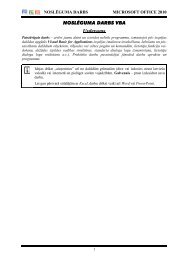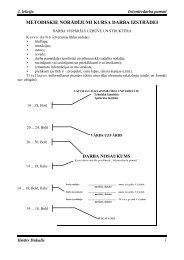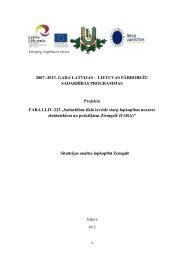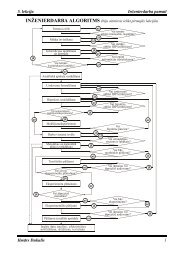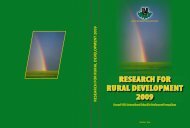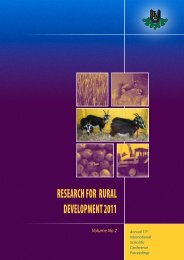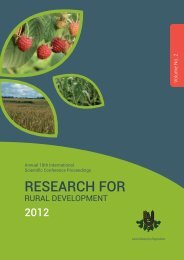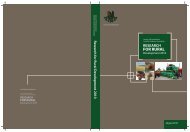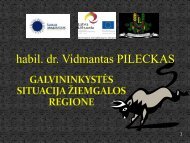LATVIA UNIVERSITY OF AGRICULTURE - Latvijas ...
LATVIA UNIVERSITY OF AGRICULTURE - Latvijas ...
LATVIA UNIVERSITY OF AGRICULTURE - Latvijas ...
- No tags were found...
Create successful ePaper yourself
Turn your PDF publications into a flip-book with our unique Google optimized e-Paper software.
Birgit Aasmäe, Piret KalmusANTIMICROBIAL RESISTANCE <strong>OF</strong>ANIMAL PATHOGENS 2006-2009 IN ESTONIAAntimicrobial resistance of S. aureus isolated fromclinical mastitis milk samples is shown in Table 4.The resistance levels of S. aureus strains weregenerally low, except against penicillin. Resistance topenicillin incerased over the four years from 58% to85%. Also, 8% of cephalotin resistant isolates weredetected in the years 2008-2009. MeticillinresistantS. aureus (MRSA) was found during monitoringprogram. In 2009, resistance to lincomycin (30%) andfucidinic acid (22%) was detected. Table 5 describesresistance of S. pseudintermedius and S. auruesisolated from ear and skin samples of Estonian dogsbetween 2006-2009.The prevalence of resistance to penicillin dueto production of betalactamases (penicillinase) inS. pseudintermedius is high, 52-81%. An oxacillinresistant S. pseudointermedius was isolated in 2007 and2008 with presence of meqA gene. In 2008, resistanceto ciprofloxacin was observed. Data from 2009 shouldbe interpreted with caution due to very small amountof isolates that year. Multidrug resistance is relativelystable being 38% in 2006, 29% in 2007 and 25% in2009. The present monitoring program describes thesituation of antimicrobial resistance and trends inEstonia in the years 2006-2009.The prevalence of acquired antimicrobial resistancein commensal bacteria of the enteric microflora ofhealthy animals indirectly indicates the magnitude ofthe selective pressure from the use of antimicrobialsin animal population. The resistance level of entericmicroflora in pigs is higher in Estonia in comaprisonwith Sweden and Norway (Bengtsson et al., 2010;Kruse and Skov, 2004), but is similar to reportsfrom Denmark (Jensen et al., 2010) and Netherlands(Mevius et al., 2009). Both E .coli and enterococcishowed highest resistance to tetracyclin which canbe explained with wide use of doxycycline for oraltreatment of pigs. Also, tylosin and sulfonamidesTable5Resistance of Staphylococcus spp. isolated from dogs in case of otitis externa or from skin samples ofEstonian dogs between 2006-2009Antimicrobial agentsPenicillin*CefalotinOxacillin+2% NaCl**Erythromycin*Chloramfenicol*Clindamycin**Tetracyclin*Fucidinic acid**Gentamycin*Kanamycin**Ciprofloxacin*Trimethoprim*Breakpointµg mL -1 *≥0.13 S.intermedius≥ 0.13 S.aureus≥2 S.intermedius≥1 S.aureus≥1 S.intermedius≥2 S.aureus≥1 S.intermedius≥1 S.aureus≥16 S.intermedius≥16 S.aureus≥4 S.intermedius≥ 0.25 S.aureus≥8 S.intermedius≥1 S.aureus≥ 4 S.intermedius≥ 0.5 S.aureus≥4 S.intermedius≥2 S.aureus≥8 S.intermedius≥8 S.aureus≥1 S.intermedius≥1 S.aureus≥2 S.intermedius≥2 S.aureus2006% (n=21)2007% (n=17)2008% (n=16)53 71 81 630 0 31 00 18 31 029 29 44 1324 12 19 1324 12 44 1324 41 25 2514 12 6 130 12 31 130 24 44 250 0 38 1367 76 63 382009% (n=8)Coagulase negative staphylococci (CNS) and Staphylococcus aureus (S.a.).Test: VetMIC GP-mo (version 2).* Epidemiological cut-off values from EUCAST (European Committee on Antimicrobial Susceptibility Testing)** Breakpoints from SVARM 2007 (Swedish Veterinary Antimicrobial Resistance Monitoring ISSN 1650-6332 Uppsala,http://www.sva.se).Research for Rural Development 2012185



